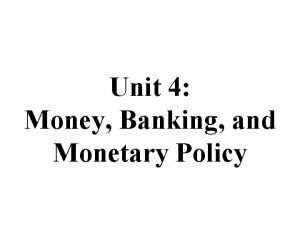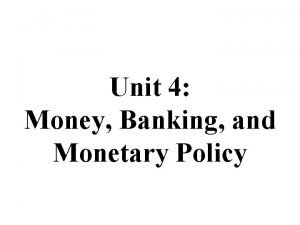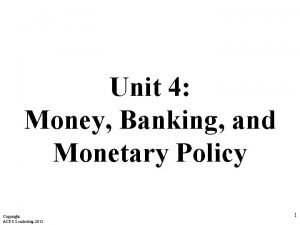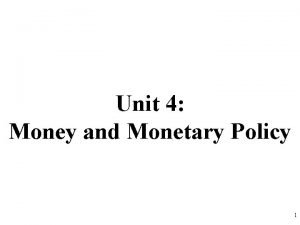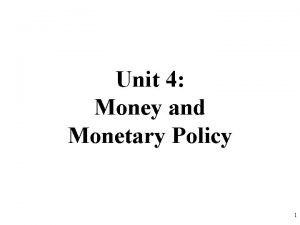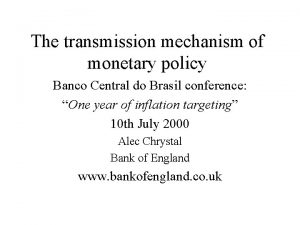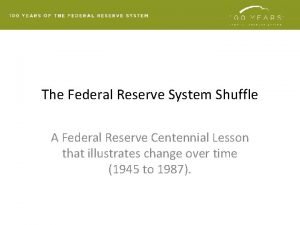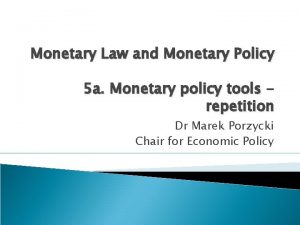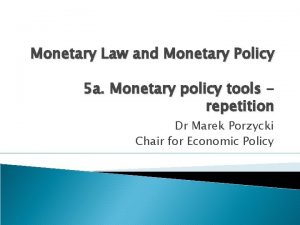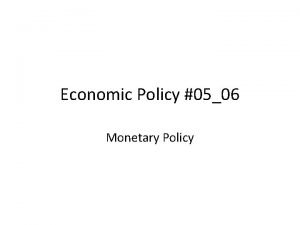Monetary Law and Monetary Policy 5 Functions of









- Slides: 9

Monetary Law and Monetary Policy 5. Functions of a central bank. Seigniorage Dr Marek Porzycki Chair for Economic Policy

Overview 1. Traditional functions of a central bank - issuer of currency - „bank of banks” - „lender of last resort” - fiscal agency function 2. Seigniorage

Issuer of currency In most countries/currency areas, the central bank has the exclusive right to issue currency. Euro area: Art. 128 of the TFEU - issuance of euro banknotes by the ECB and national central banks. ECB’s exclusive right to authorise the issue of banknotes. - issuance of euro coins by Member States subject to approval of volume of the issue by the ECB Poland: Art. 4 of the Law of 29. 8. 1997 on the National Bank of Poland - NBP’s exclusive right to issue the currency of the Republic of Poland

Issuer of currency - exceptions - - - Historically, banknotes were issued by commercial banks rather than a central bank (as IOU of the issuer). „Free banking era” in the United States (1837 -1862) Some current examples: Scotland Northern Ireland: commercial banks are authorised to issue banknotes in pound sterling (GBP), which are not legal tender but are accepted in circulation Hong Kong dollar (HKD): most banknotes in circulation are issued by 3 authorised commercial banks. Only HKD 10 note is issued by the HK Monetary Authority Macau pataca (MOP): banknotes are issued by two authorised commercial banks

„Bank of banks” - - - accepting deposits from commercial banks and extending loans to them, within the framework of monetary policy tools operation of payment systems RTGS systems (real-time gross settlement) clearing: calculating the respective obligations of participants (done NOT by central banks but by clearing houses, e. g. ELIXIR system operated by KIR in Poland) settlement: actual payment, by crediting/debiting accounts of the commercial banks (done by RTGS systems operated by central banks) TARGET 2 – interconnection of national RTGS systems run by the ECB and EU central banks SORBNET 2 and TARGET 2 -NBP in Poland

„Lender of last resort” Central bank extends credit to distressed banks when other sources of financing are not available. prevention of bank runs applicable to distressed but solvent banks: need to distinguish temporary illiquidity from insolvency In normal times banks are usually not willing to use this possibility, in order to avoid an appearance of being in crisis. example: ECB’s Emergency Liquidity Assisstance (ELA); refinancing loan by the NBP (under Art. 42 of the Law on the NBP)

Fiscal agency function traditional function of the central bank in some countries but not a core central bank function maintaining banking accounts of the State Treasury and/or public institutions and providing banking services to them relation to the prohibition of monetary financing: no overdraft facilities nor other form of credit allowed example in Poland: Art. 51(1)(2) of the Law on NBP Banking services to the public sector can also be provided by the Bank Gospodarstwa Krajowego (BGK). The NBP will lose its monopoly on providing basic banking services to the State Treasury from the date of the adoption of the euro. The Minister of Finance will choose between the NBP and the BGK. See Art. 196 of the Law of 27. 8. 2009 on public finance

Seigniorage income of the central bank resulting from issuance of currency Traditionally seigniorage was the income of the sovereign resulting from the difference between the intrinsic value of the material (bullion) used to mint the coin and its face value incentive for debasement of money A remnant of this traditional form of seigniorage results from withdrawal of coins from circulation for collection purposes the issuer gains the difference between the face value of the coin and the cost of its production. Examples: commemorative 2 EUR coins; „ 50 States” series of quarters (0, 25 USD coins).

Seigniorage – current use Banknotes are a liability of the issuing central bank which does not bear interest. The issuing central bank transfers banknotes to commercial banks in return for financial assets which earn interest (e. g. Treasury bonds). In result the central bank incurs an interest-free liability in return for interest-earning assets. Interest earned on those assets (minus costs of production and distribution of notes) constitutes seigniorage – income of the central bank resulting from the issue of banknotes. Incentive for promoting the use of one’s own currency abroad (cf. US dollar) holding banknotes is akin to granting an interest-free loan to the issuing central bank.
 Unit 4 money banking and monetary policy
Unit 4 money banking and monetary policy Unit 4 money banking and monetary policy
Unit 4 money banking and monetary policy Monetary and fiscal policy interactions activity 5-5
Monetary and fiscal policy interactions activity 5-5 Unit 4 money and monetary policy
Unit 4 money and monetary policy Unit 4 money and monetary policy
Unit 4 money and monetary policy Unit 4 money and monetary policy
Unit 4 money and monetary policy Transmission of monetary policy
Transmission of monetary policy Lesson quiz 16-1 monetary policy
Lesson quiz 16-1 monetary policy Meaning of monetary
Meaning of monetary Monetary policy meaning
Monetary policy meaning
